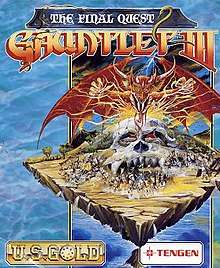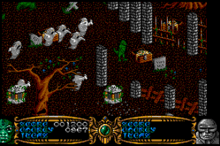Gauntlet III: The Final Quest
Gauntlet III: The Final Quest is a home computer game by U.S. Gold and Tengen it was released in 1991 for the Amiga, Atari ST, Commodore 64, ZX Spectrum, and Amstrad CPC. Besides the standard four main Gauntlet characters, Thor, Thyra, Merlin, and Questor, four new playable characters were available: Petras, a rock man; Dracolis, a lizard man; Blizzard, an ice man; and Neptune, a Merman.[2] The game is viewed from an isometric perspective and includes a two-player cooperative multiplayer mode.
| Gauntlet III: The Final Quest | |
|---|---|
 Gauntlet III Commodore 64 box art | |
| Developer(s) | Tengen Software Creations (Amiga, Atari ST) |
| Publisher(s) | U.S. Gold |
| Director(s) | David Broadhurst[1] |
| Designer(s) | Michael Delves[1] Paul Salmon[1] |
| Programmer(s) | Bill Barna (Atari ST)[1] Michael Delves (Amiga)[1] |
| Artist(s) | Paul Salmon[1] Chris Collins[1] |
| Composer(s) | Timothy Follin[1] Geffrey Follin[1] |
| Series | Gauntlet |
| Platform(s) | Amiga, Amstrad CPC, Atari ST, Commodore 64, ZX Spectrum |
| Release | 1991 Amiga & Atari ST Spring 1991[1] |
| Genre(s) | Hack and slash, dungeon crawl |
| Mode(s) | Single-player, multiplayer |
Plot
A land called Capra was having many wars among its kingdoms; peace would come but then another war would start. Then one day a wizard named Magnus came and brought peace, but to make sure there would never be another war he created a door to the dark dimensions from which evil things would come, if there was ever another war. "This be the Final Peace for if it is broken, all Capra will be at the mercy of the devourers."[3] Then the Velcrons came to these kingdoms. They were servants of the things behind the door. They took over the magic kingdom and their king, Capricorn, held the wizard as his captive. Evil slowly came from this magic kingdom, bringing plagues, and even poisoning the food. The people of these lands begin to hate, and the peace was threatened. Eight champions have come to try and put an end to the darkness covering their land.
The back side of the box has the tagline, "The Gates of Hell are Open..." The cover illustration is by Peter Andrew Jones.
Gameplay
Gauntlet III is an original game with an isometric projection type view that would later be used in Gauntlet Legends and other Gauntlet games made after Legends. Its view is much like that of Solstice and games made with the Filmation engine. The player walks around various areas of each kingdom, with five areas for each of the eight kingdoms giving a total of 40 areas.[4] The locations can be traversed from one area to the next. Places like the forest and castle dungeons have obstacles such as logs and tables blocking the player's path, creating a maze-like area. Each area has at least one doorway or pathway to the next. At times certain things must be done in order to advance into the next area. To avoid the player being lost the programmers created a hand that appears from time to time, holding a note to remind the player what they are supposed to do; this clue feature is also an option to call up the clues.[4] Another feature programmed into the game is a combination lock key code for which the player must consult a code wheel packaged with the game, needed to open certain doors; if someone made a pirated version of the game they wouldn't be able to get past that portion of the game without the Combination Key.
The enemies in this version, as in other Gauntlet games, come mostly from generators that keep producing the enemies until the generators are destroyed. Other elements from the series also make an appearance, such as potions that make enemies disappear or weaken them, food (both good and poisonous), invincibility amulets, and treasure chests, some of which can contain traps or other items the player would need.
Development
The Amiga and Atari ST versions of Gauntlet III: The Final Quest, as developed by Software Creations, began development in the Summer of 1990, and were released in the Spring of 1991 for the Amiga and Atari ST; a DOS version was in development and announced for Spring 1991, but was never released.[1] In a January 1991 issue of British gaming magazine The One, The One interviewed team members from Software Creations for information regarding Gauntlet III's development in a pre-release interview.[1] The design specifications for Gauntlet III were left up to the developer, and Software Creations's development team originally conceived Gauntlet III as a 2D maze game like its arcade predecessors, but the team wanted something 'more original'.[1] David Broadhearst, Gauntlet III's development manager, stated that Gauntlet III became a 3D game because "We'd never seen anybody do a really good 3D scrolling game with masking before - most of them are just static screens, generated one after the other - so we decided to do one which scrolls around like one big map."[1] Gauntlet III's team noted the core gameplay of the original Gauntlet as "simple"; Richard Kay, the founder of Software Creations, expressed that the team tried to 'remain faithful' to the gameplay of the originals, but through a 3D perspective.[1]
Few monsters from the original games are in Gauntlet III by design; a Gauntlet III development team member expressed that "Ghosts were pretty much characteristic [of Gauntlet]" thus they were kept in Gauntlet III, but otherwise the team opted for new monsters, such as sharks and triffids.[1] Development first began on the Atari ST version, with this version planned to be ported to the Amiga, but this was soon reversed, due to the Amiga's hardware scrolling capabilities.[1] One of the main complications in Gauntlet III's development was the game's sprite masking: Paul Salmon, Gauntlet III's graphic artist, stated that "Every time a sprite moves behind an object it halves the speed of the sprite routine and slows the game by a factor of two."[1] Salmon designed the sprite masking algorithm, as well as many methods of saving memory.[1] Michael Delves, the programmer of the Amiga version of Gauntlet III, expressed that the way that the game's sprites are arranged saves on memory, and that for this same reason, not all sprites are masked.[1] Delves stated that the masked sprites are "usually balanced out by ordinary sprites", and that rooms with many monsters have less masked sprites as a result.[1] Due to the game's 3D environment, an issue arose in that monsters got stuck on walls & the game environment.[1] This was remedied through the addition of AI, but the team felt conflicted about adding this to the game's ghosts, as they felt they'd be "changing the game".[1] Each of Gauntlet III's eight playable protagonists have 72 frames of animation each; due to memory restrictions, one frame of animation is used twice in each sequence.[1]
Keeping track of items in the player's inventory was also a difficulty due to memory restrictions; because of this, the collectible potions in the original arcade games are cut, they are instead automatically used upon being collected.[1] Gauntlet III's graphics were illustrated using OCP Art Studio by Paul Salmon and Chris Collins; Salmon predominantly worked on sprites, while Collins did backdrops.[1] Both the Amiga and Atari ST versions use a 16-color palette, although the introduction uses 32-colors.[1] Gauntlet III is rendered in 16 colors due to the game's sprite masking: a Gauntlet III team member stated that "If we used five bit planes the game would slow down because it'd have to mask five bit planes as well."[1]
Reception
| Reception | ||||||||||||||
|---|---|---|---|---|---|---|---|---|---|---|---|---|---|---|
| ||||||||||||||
Most reviews praised the games graphics, but some found they were over used in many places with very little variation.[7] These reviews seem to center around the fact that the player is required to go from location to location and complete certain tasks, and follow a certain route to achieve these goals.[4][6] Another problem with the graphics was that the backgrounds would shift as the player advanced,[2] and that of the enemies themselves blocking the view covering the player and background.[7] One of the games' main attractions was the well received music by video game composer Tim Follin.[2][7][5]
British gaming magazine The One gave the Amiga version of Gauntlet III an overall score of 87%, praising the game's 3D perspective, stating that "Thanks to the 3D facelift and the addition of some nifty problem-solving, the main problem associated with the first two Gauntlets - repetitiveness - has been obliterated." The One further praised the shift to isometric 3D graphics, expressing that it "replace[s] the struggle to amass points and move on to the next level with a touch of puzzleability and some genuinely different graphics." The One further praised Gauntlet III's "impressive" graphics, "fast" eight-way scrolling, and further stated that the "huge array of innovatively-designed monsters gives plenty of incentive to see what's waiting around the next corner." The One praised Gauntlet III's soundtrack, stating "it just has to be heard to be believed!", but criticized Gauntlet III as being 'unoriginal' - calling it a "glorified hack and shoot 'em up" - but very fun.[4]
External links
- Gauntlet III: The Final Quest at Hall of Light Amiga database
- Gauntlet III: The Final Quest at MobyGames
References
- Hamza, Kati (January 1991). "Running the Gauntlet". The One. No. 28. emap Images. p. 37-38.
- "Gauntlet III: The Final Quest Review". Amiga Action. No. 25. Europress Interactive. October 1991. p. 106.
- Instruction Booklet for Gauntlet III: The Final Quest
- Hamza, Kati (April 1991). "Gauntlet III: The Final Quest Review". The One. No. 31. emap Images. p. 56.
- Merrett, Steve (September 1991). "Gauntlet III". CU Amiga. emap Images. p. 100-101.
- Davies, Jonathan (September 1991). "Game Reviews: Gauntlet III". Amiga Power. No. 5. Future Publishing. pp. 40–41.
- Leach, James (October 1991). "Screenplay: Gauntlet 3". Amiga Format. No. 27. Future Publishing. p. 87.
